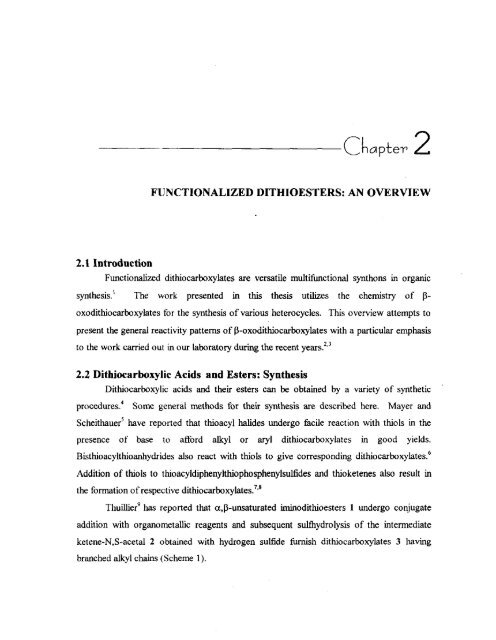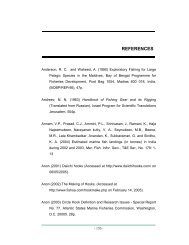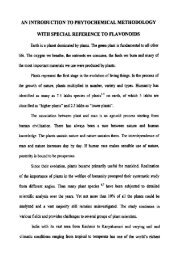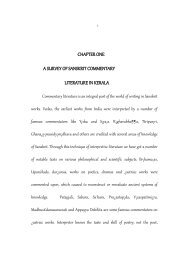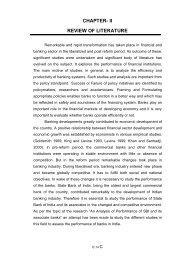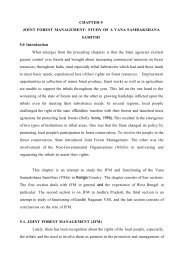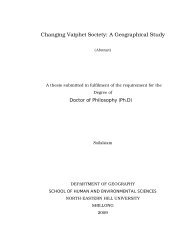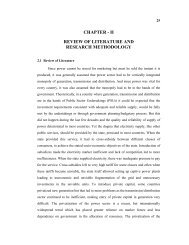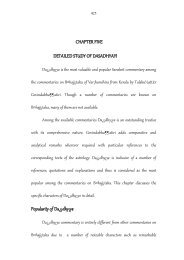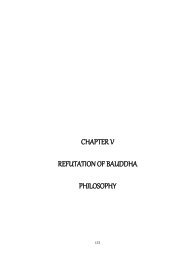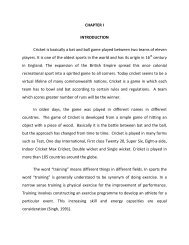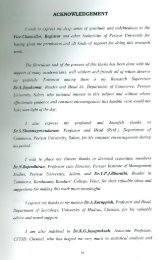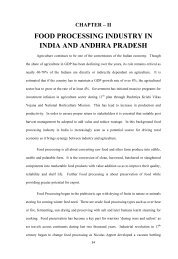Synthesis
Synthesis
Synthesis
Create successful ePaper yourself
Turn your PDF publications into a flip-book with our unique Google optimized e-Paper software.
Scheme ISchuijl and co-workers have shown that terminal alkynes can also be used in thesynthesis of dithioesters. For example propyne 4 on treatment with butyl lithium and thenwith elemental sulfur furnish the corresponding lithium alkyne thiolate 5 which onsubsequent addition of two equivalents of thiol gives the dithioester 6 (Scheme 2)''Scheme 2Dithiocarboxylic acids can also be obtained by the addition of organolithium reagentsto carbon disulfide. For example a-hydroxynaphthyl lithium 7 on addition to carbondisuffide gave dithiocarboxylic acid 8 (Scheme 3)."
Scheme 3Several functional groups can be transformed into dithiocarboxylic acids or dithioesters bysulfurization. Aldehydes can be transformed into corresponding dithiocarboxylic acids bytreatment with hydrogen sulfide or ammonium polysulfide.12 Thioiminoesters in pyridine orether on treatment with hydrogen sulfide gave dithioesters in good yield. Thioiminoesters13are obtained by the simple addition of thiols to nitriles .Long cham carboxylic acidsalso have been converted to dithiocarb~xylates.'~ The carboxylic acids first transformed intodilithioketeneacetals 9 which on reaction with carbon disulfide followed by alkylation withmethyl iodide and decarboxylation gave the dithiocarboxylates 11. The synthesis of methyldithiononanoate by this method has been depicted in (Scheme 4).OLiIScheme 4
Carbanions derived &om malonic acid,'' phenols, naphthols, hydroxy quinolines,'6aldehydes," ketones," nitromethane,19 pyrroles, indoles, quinolines and their derivativesalso react with carbon disulfide to afford respective dithiocarboxylic acids.2.2.1 <strong>Synthesis</strong> of P-Oxodithiocarboxylic acids and EstersAmong hctionalized dithiocarboxylic acids, p-oxodithiocarboxylic acids and theiresters are valuable 1.3-bielectrophilic three carbon synthons with potential applications inthe synthesis of heterocycles. They are usually prepared by the thiocarbonylation of activemethylene ketones. Recent studies in our laboratory have shown that they can also bederived from a-oxoketenedithioacetals.P-Oxodithiocarboxylic acids are synthesized by the reaction of enolizable ketoneswith carbon disuhide in the presence of a strong base. Aliphatic and cyclic ketones reactwith carbon disulfide in the presence of sodium f-pentoxide to afford corresponding P-oxodithiocarboxylic acids (Scheme 5)."Scheme 514P-Oxodithioesters can be synthesised fiom substituted acetophenones by the additionof carbon disuhide in the presence of potassium t-butoxide followed by alkylation (Scheme6) l2
Scheme 6Active methylene compounds, on treatment with diiethyl trithiocarbonate in thepresence of sodium hydride as a base in DMF, gave P-oxodithioesters 20 in good yields(Scheme 7)." Dithioesters of sulfones and sulfoxides can also be prepared by this method.14-NaHDMFS MeScheme 7Earlier studies kom our laboratory have shown that when ethylacetoacetate reactswith dimethyl trithiocarbonate in the presence of sodium hydride in benzene, carbethoxysubstituted dithioacetate 23 is formed which indicates that the intermediate dithioester 22undergoes a base induced deacylation (Scheme 8).'
Eioa-NaHMeS SMe DMF, benzeneSMeEtoSMeScheme 8Oliva and co-workers have reported that doubly activated active methylene ketonessuch as 2,4-pentanedione on treatment with dimethyl trithiocarbonate in the presence ofsodium acetate in DMF, methylthiothiocarbonylation takes place effectively leading to theformation of 25 in good yield (Scheme 9).2sMeS 'SMe-NaOAc, DMFr.t. 24 hScheme 9252.2.1.1 <strong>Synthesis</strong> of POxodithwcw~Iates from a-Oxoketenedithioacetalsa-Oxoketenedithioacetals 2gcan be prepared in good yields from active methyleneketones on their reaction with carbon disuffide followed by alkylation.26 Therefore their
conversion to P-oxodithioesters would provide an alternative and convenient access to theseintermediates.A convenient method for the transformation of a-oxoketenedithioacetals to P-oxodithioesters has been recently reported fiom ow lab~ratory.~' For example when H2Swas bubbled through a refluxing mixture of an atoyl ketenedithioacetal and BF, etherate therespective atoyldithioesters 27 were obtained in good yields (Scheme 10).RSMeScheme 10The ketenedithioacetals prepated fiom cyclic and aliphatic ketones also gavecorresponding P-oxodithioesters on treatment with hydrogen sulfide in the presence of aLewis acidSodium methylsulfenylmethylide is a highly versatile reagent as a base as well as anucleophile. Demethylation reactions of substituted aromatic compounds induced by theattack of dimsyl anion ate known.28 Similarly a selective demethylation reaction of dimethylketenedithioacetals with dimsyl sodium should result in the formation of P-oxodithioesters.Atoyl ketenedithioacetals 26 on treatment with methylsulfenylmethylide in DMSO gaverespective P-oxodithioesters in good yields (Scheme 11).29Scheme 11
a-Oxoketenedithioacetals derived &om cyclic and aliphatic ketones also gave therespective P-oxodithocarboxylates in good yields on treatment with dimsyl sodium. Aprobable mechanism for thls demethylation reaction involve the nucleophilic attack of thedirnsyl anion on one of the methylthio groups of the a-oxoketenedithioacetals resulting inthe demethylation. The enethiolate anion formed on protonation afford thedithiocarboxylates.2-Ylidene-l,3-dithiolanes are known to undergo base induced ring opening to affordrespective vinyldithiocarboxylates.30 Thus the dithiolane 28 on treatment with LDA in THFin the presence of HMPA afFord the dithioester 30 (Scheme 12).R'2RSLiaq. HCIR'SScheme 12We have recently shown that this protocol can also be used for the preparations ofvinyl P-oxodithiocarboxylates. Thus, when 2-aroylmethylidene-l,3-dithiolanes were treatedwith methy sulfenylrnethylide prepared &om DMSO and sodium hydride the respective vinylbenzoyldithioacetates 32 were formed in excellent yields (Scheme 13).~'Scheme 13
This transformation also has been found to be general hd efficient for a wide variety ofaliphatic and cyclic a-oxoketenedithioacetals as well.Another valuable method for the synthesis of vinyldithioesters involves the Wittigreaction of (triphenylphosphonium)methylarenecarbodithioate iodides 33 with aldehydes.)'The phosphonium iodides 33 were prepared &om piperidinium salts of arenedithiocarboxylicacids (Scheme14).32Scheme 142.2.2 <strong>Synthesis</strong> of a#-Unsaturated DithiocarboxylatesThough a$-unsaturated dithioesters are versatile intermediates in organic synthesisthere are only a few practical methods in the literature for their synthesis. A summary ofgeneral and important methods for their synthesis are given here with an emphasis to therecent results &om our laboratory. Thiolate anions obtained by the addition of vinyl cuprateto carbon disultide on alkylation lead to the formation of a-ethylenicdithioesters 39 (Scheme15) ''38Scheme 15
Hartke and co-workers have shown that a$-unsaturated amides can be transformedto a,P-unsaturated dithioesters through a sequence of reactions. The amide 39 on treatmentwith triethyl oxonium tetrafluroborate afford the ethoxy substituted irninium salt 40. Itcould be transformed into thionoester 41 by treatment with hydrogen sulfide at lowtemperature. Subsequent treatment with piperidii leads to the formation of the thioamide42. The thioamide on alkylation followed by suUhydrolysis at low temperature afford thedithiocinnamate 44 (Scheme 16).j4Scheme 16
The addition of Grignard reagent 46 to phenyl isothiocyanate results in theformation of an intermediate N-phenylthiocarboxyirnidate 47, which on treatment withhydrogen sulfide affords the y,&unsaturated dithioesters 48. This can be isomerized to thecorresponding a$-unsaturated dithioester 49 &the presence of triethylamine (S~herne17).~~Scheme 17Gosselin er. al. have reported that pyrolysis of the bridged dithioester 50 gave methylpropenedithioate 51 (Scheme 18 ).j6 The unstable dithioate could be trapped in a CFC13 orCDC13 matrix at -196 OC. At higher temperature it undergoes a facile dirnerisation involvinga [4+2] cycloaddition.Scheme 18
a,P-Unsaturated dithloesters are also obtained by the Petersons reaction of trimethylsilyl dithioacetate with aldehydes (Scheme 19).37Scheme 19a-Ethylenicdithioesters could be synthesised from P-hydroxydithioesters also. P-Hydroxydithioesters are obtained by the addition of thioenolate anion derived frommethyldithioacetate 55 to carbonyl compounds. The elimination of water 6om P-hydroxydithioesters under diierent conditions lead to the formation of corresponding a$-unsaturated dithioesters 58 (Scheme 20).'~SMe58Scheme 20The carbanions generated 6om aliphatic dithiocarboxylic acids 59 on treatment withbutyl lithium add to aldehydes or ketones to give aldols 60 which on subsequent alkylationand dehydration afford corresponding a$-unsaturated dithioesters 58 (Scheme 21).39
H, CBuLi ( 2 equiv.)59 56 60-MelK,oRSMe - H20dScheme 21j3-Hydroxydithioesters 62 were also obtained by the selective addition oforganometallic reagents to a-substituted methyl acetodithioacetates 61. Their dehydrationby treatment with p-toluenesulfonic acid or methyl sulfonyl chloride afforded a$unsaturateddithioesters 63 (Scheme 2Q4"Scheme 22
P-Amino~ubstituted-a~P-unsaturated dithiocarboxylates can be synthesized from 3-thioxo-1,2-dithiole 64.When 64 was treated with morpholine in chloroform theintermediate dithiolate 66 was formed which on subsequent alkylation gave 3-morphoIinodihioacrylate 67 ( Scheme 23).4'-Scheme 2367Alternatively initial alkylation of the dithiole-3-thione 64 by methyl iodide followedby reaction with aruline gave the P-phenylaminodithioacrylate 69 (Scheme ~ 4).~'SSMeScheme 24
In our laboratory a facile method for the preparation of a,P-unsaturated dithioestersfrom ketenedithioacetals has been developed recently. a-Oxoketenedithioacetals 26 onselective reduction using sodium borohydride gave the carbinol acetals 70, which ontreatment with Lawesson's reagent:' gave the corresponding dithioesters 71 (Scheme 25).19L. W benzene___)reflux, 1-1.5hR FC7 1Scheme 25This method can be extended for the synthesis of P-disubstituted a,P-unsaturateddithiocarboxylates as well. The ketenedithioacetal 26 derived kom substitutedacetophenones on treatment with methyl Gngnard gave the resulting intermediate carbiolacetals 72 which was subjected to the reaction with Lawesson's reagent to afford thediihioesters 73 in good yields (Scheme 26).29
L. RI benzene-R reflux, I-1.5hScheme 26Ketenedithioacetal derived kom aliphatic ketones also follow the same reactionpathway. For example acyketenedithioacetals on the addition of methyl Grignard andsubsequent treatment with Lawesson's reagent gave methyl-3-methyl-2-butenedithioate 292.2.3 <strong>Synthesis</strong> of a-OxodithiocarboxylatesThere are only a few methods available for the preparation of a-oxodithiocarboxylates.Some of the kequently used methods for their synthesis aredescribed here. Methyl benzoyl dithiocarboxylates are obtained by the reaction ofbenzaldehyde with carbon disulfide in the presence of potassium cyanide and subsequentallcylation with dimmethane (Scheme 27).43Scheme 27
a-Oxodithioesters were also obtained &om aryl methyl ketones. Methyl ketones ontreatment with pyridine and iodine leads to the intermediate pyridinium salts which reactwith sulfur in the presence of triethyl amine to afford conesponding a-oxodithioester 76 onsubsequent alkylation (Scheme 28).4479 76Scheme 28Alexander and co-workers have also accomplished the conversion of aryl methylketones to corresponding a-ox~dithiocarbox~lates.~~ Substituted acetophenones are treatedwith ethyldisulfide in the presence of a base, such as sodium t-butoxide, and subsequentalkylation with methyl iodide give the a-oxodithiocarboxylates 76 (Scheme 29).Scheme 2976
2.3 Dithiocarboxylic acids and Esters: ReactionsDithiocarboxylic acids and esters are valuable precursors for the synthesis of severalheterocyclic compounds. Lithium or sodium enethiolates can easily be obtained fromdithiocarboxylic esters. Enethiolates have some advantages over enolates derived fromenolizable ketones. 'They have good thermal stability and do not undergo equilibrium withthe proton donors. Formation of enethiolate is highly stereospecific and cis isomers isformed exclusively (Scheme 30).~~80 81Scheme 306-Ketodithioesters are obtained by the Michael addition of lithium enethiolate toa$-unsaturated carbonyl compounds. The Michael addition takes place stereospecificallyunder kinetically controlled conditions ( Scheme 31).~~Scheme 31Ketenedithioacetals are synthesised by the base catalysed alkylation of dithioesters."Sulfones and sulfoxides are valuable intermediates in organic synthesis. They are obtainedby the oxidation of dithioesters. Aliphatic sulhes are obtained by the oxidation of aliphatic
dithioester with m-chloroperbenzoic acid in methylene chloride and it undergoesrearrangement to corresponding dithioperoxy ester at room temperature (Scheme 32).4985Scheme 32Thiolesters are obtained by the oxidation of dithiocarboxylates withanhydride (Scheme 33).50selenic55 87Scheme 332.3.1 Reactions of ~oxodithioestenP-Oxodithioesters are potential multifunctional synthons useful in the synthesis ofheterocyclic compounds. They are also useful precursors for the synthesis of P-oxothioamides and functionalized ketene-N,S-acetals. P-Oxodithiocarboxylates on treatmentwith trimethyl silyl sulfide in the presence of N-chlorosuccinimide and imidazole leads to theformation of substituted 3-thioxo-l,2-dithioles (Scheme 34)."Scheme 34
Scheme 37Methyloacetdithioacetate 98 has been shown to react with dithiolyim salt 99 toafford 3-acetyl substituted 2H-thiopyran-2-one derivatives 100 (Scheme 38).54Scheme 38When P-oxodithioesters were treated with chloromethylene~um salt, preparedfrom POCb and DMF 0-chloro P-alkylthio, a$-unsaturated ketones were ~btained.'~ Thusaroyl dithioacetates on treatment with Vilsmeier reagent, gave 3-chloro-3-methylthio-l-phenylpropenone 101 (Scheme39).27 101Scheme 39
The dithiocarboxylate 102 obtained from cyclohexanone on treatment with Vilsmeierreagent prepared horn POCb and DMF to afford 2-chloro-3-(1-chloro-lmethylthio)methylene cyclohex-ene-carbaldehyde 103 (Scheme 40),which has formed as a result ofmultiple iminoalkylations.Scheme 40Carbethoxy dithoacetate 23 on treatment with chloromethylene iminium saltprepared from POCI, and DMF gave 2H-thiopyran-2-one derivative 104 (Scheme 41).'23Scheme 41P-Oxodithioesters on alkylation using a-haloesters, bromocrotonate and a-halonitriles lead to the formation of several heterocyclic compounds s'The reactions of P-oxodithioesters with dicyclohexyl carbodiimide have been studiedrecently in our laboratory.5b The reaction was aimed at the activation of the thiocarbonylgroup for selective displacement with other nucleophiles. However, it has been found thatafter the initial addition of the adduct undergo cyclization involving intramoleculardisplacement of the methylthio group. For example when methyl aroyl dithioacetates are
treated with two equivalents of DCC in the presence of DMAP in CHzClz, 4-aroylmethyLidene-3-cyclohexylimino-l,3-thiazetidenes 106 are formed (Scheme 42).Scheme 42The brief discussion given above on the preparation and reactions of dithiocarboxylatesindicates that even though they are compounds which can be prepared easily !?om readilyavailable starting compounds, their applications in the synthesis of functionalizedheterocyclic compounds and in other synthetic transformations have not been explored inmuch detail.
2.4. References(a). Doyl, K.M.; Kurzer, F. Chem. Ind. [London] 1974,403(b) Reid, E.E. Organic Chemistry ofBivalent Sulphur. Vol. 1-6, Chemicalpublishing Co. Inc. New York, 1958-1966(c) Scheithauer, S.; Mayer, R. Thio and dithiocarboxylic acids and theirderivatives. Topics in sulfur chemistry, Vol. 4, A senning, Ed., Georg ThemVerlag, Stuttgart 1979(d ) Ramdas, S.R.; Srinivasan, P.S.; Ramachandran, J.; Sastry, V. V. S. K.<strong>Synthesis</strong> 1983,605Sum& S. Ph. D. Thesis, Mahatma Gandhi University, Kottayam 1997(a) Brown, D.J. in 'The pyrimidines' Weissberger, A. Ed., Intersciecce Publishers,New York, London, 1962, Chapter viii p. 272( b) Suma, S.; Asokan, C.V. Synth. Commun. 1996, 26, 847Voss. J. Comprehensive Organic ~ynthesis. Ed. Trost. B.M. pergamon press,Oxford: New York, 1990, 6,435Mayer, R.; Scheithauer, S. Methoden Org. Chem. [Houben- WeyC] 1985, E 5 (2), 891.Martin, A.A.; Barnikow, G. Z.Chem. 1987,27, 90Kato, S.; Goto, M.; Hattori, R.; Nihiwaki,I(.-i; Mizuta, M.; Ishida, M Chem. Ber.1985,118, 1668Schaumann, E. Tetruhedron, 1988,44, 1827(a) Thuiller, A. Phosphorous Sulfur 1985,23,253( b) El. Jazouli, M.; Masson,S.; Thuillier,A. Sulfur. Lett. 1984.2, 147. Chem.Abstr . 1985, 102. 131514.(a) Schuijl, P. J. W.; Brandsma, L; Arenes, F.J. . Recl. Trav. Chim. Pays-Bas.1966,85, 889(b) Schuijl, P.J.W.; Brandsma, L. Recl. Trav. Chim. pays-Bas 1969, 88, 513Pribram, R.; Glucksmann, C. Monatsh. Chem. 1895,15,605(a) Westmijze, H; Kleijn, H.; Vermeer, P. <strong>Synthesis</strong> 1979,432
(b) Bruni, G.: Levi, T. G. Atti. Accad. Naz. Lincei 1923,32,5.; Chem. Abstr. 1924,18,2693(c) Bruni, Ci. J. Chim. Id. Appl. 1922, 4, 533.; Chem. Abstr. 1923,17, 162513 (a) Sakurada. Y Mem. Coll. Sci. Kyoto. Imp. Univ. Ser. 1926, A. 10, 79. Chem.Abstr. 1927, 21, 3609(b) Jensen, K.A.; Pedersen, C. Acta Chem. Scand. 1961, 15, 1087(c) Poupaert, J .;Bruylants,A.;Crooy,P.; <strong>Synthesis</strong> 1972, 623(d) Doyle, F.P.; Ferrier, W.; Hollandc, D.O.; Mehta, M.D.; Nayler, J. H. C. J.Chem. Soc, 1956, 73,2853.14 Knoen, D. A.; Pfeffer, P.E.; Silbert, S.L. Tetrahedron 1976,32, 250715 (a) Jensen, K.A.; Hentricksen, L. Acta Chem. Scand. 1968,22, 1107(b) Scheffer, F.; Kickuth, R.;. Germanpatent(DBP) 1992, 1136697.; Chem Abstr.;1963, $8, 9036( c) Gompper, R.; Schaeffer, H. Chem. Ber. 1967,100,591(d) Kendall, J.D.; Edwards, H.D. Britishpatent. 1948,597446. Chem. Abstr.1948,42,4604(e) Laakso, P.V. Soum. Kemistil. 1947,41,9516 (a) Gompper, R.; Schmidt, R R.; Kuttor,E. Liebigs. Ann. Chem. 1965, 684, 37(b) Hardmarl A.F. US. Patent. 1942,2289649. Chem. Abstr. 1971, 74, 87636;( C) Gompper, R.; Schmidt, R.R. Angew. Chem. 1962, 74, 788(d) Fuchsman, H.C.; Meek, H. W. U.S. Patent. 1971,3557 194. Chem. Abstr.1971, 74, 87636.17 Saquet, M.; Thuillier, A. Bull. Soc. Chim. Fr. 1966, 158218 (a) Gompper, R.; Topfl, W. Chem. Ber. 1962,95, 2861(b) Kelber, C. Ber. Dtsch. Chem. Ges. 1910,43, 1252(c) Kelber, C.; Schwarz, A. Ber. Disch. Chem. Ges. 1911, 44, 1693(d) Thuillier, A; Vialle, J. Bull. Soc. Chim. Fr. 1959, 1398(e) Rioult, P.; Vialle J Bull. Soc. Chim. Fr. 1965,339(f) Yates, P.; W i , L..L . Tetrahedron Left. 1968, 1205
(a) Freund, E. Ber. Dtsch. Chem. Ges. 1919,52, 542(b) Gilbert, E.E. US. Patent. 1950,2513018 Chem. Absw. 1950,44,8045(c) Jensen K.A.; Buchardt, 0.; Lohse, C. Acfa Chem. Scand. 1967,21,2797(a)Rosenhauer, E. Ber. Dtsch. Chem. Ges. 1924,57, 1291(b) Schneider, W.; Gaertner, K.; Jordan, A. Ber. Dtsch. Chem. Ges 1924, 57,522;(c) Mumm, 0.; Hinz, H.; Diederichsen, J. Ber. Dtsch. Chem. Ges. 1939, 72. 2107(d) Krohnke, F; Gerlach, K. Chem. Ber. 1962, 95, 1108(e) Krohnke, F; Gerlach, K.; Schnalke, K. E. Chem. Ber. 1962,95, 1 1 18(0 Krohnke, F.; Steuernagel H. H. Chem. Ber. 1964,97, 11 18(g) Treibs, A. Liebigs. Ann. Chem. 1969, 723, 129.(a) Thuillier, A,; Vialle, J. Bull. Soc. Chim. Fr. 1962,2182(b) Thuillier, A,; Vialle, J. Bull. Soc. Chim. Fr. 1962, 2187(c) Thuillier, A.; ViaUe. J. Bull. Soc. Chim. Fr. 1962 , 2194(d) Klingsberg, E. J. Org. Chern. 1972,37,3226(a) Larsson, F.; Lawesson, S.O. Tetrahedron, 1972,28, 5341(b) Dalgaard, L.; Kolind-Andersien, H.; Lawesson, S. 0. Tenahedron 1973,29, 2077Singh, G.; Bhattacharjee. S. S.; Ila, H.; Junjappa, H. <strong>Synthesis</strong> 1982, 693Yokoyama, M.; Tsuji, K.; Hayashi, M.; Imamoto,T. J. Chem. Soc. Perkin Trans. I1984,85Oliva, A.; Molinari, A.; Sanchez, L. Synth. Commun. 1998,28, 3381(a) Thuiller, A.; Vialle, J. BUN. Chem. Soc. Chim. Fr. 1962, 2187(b) Thuiller, A.; Vialle, J. BUN. Chem. Soc. Chim. Fr. 1962,2194Nair, S. K.; Asokan, C.V. Synth. Commun. 1999,29, 791Lal, B.; Gidwani, R. M.; Desouza, N. J. J. Org. Chem. 1990,55,5 1 17Nair, S.K. Ph. U. Thesis, Mahatma Gandhi University, Kottayam 1998Saquet, M.; Thuillier. A. Tetrahedron Lett. 1980,21,2165Ishida, M.; Kaga, K. I.; Sato, H.; Yokoi, M.; Kato, S. Bull. Chem. Soc. Jpn. 1986,59, 1403Ishida, M.; Sato, H.; Kato, S. <strong>Synthesis</strong> 1982,927
Westmijze, H.; Kleijn, H.; Miejer, J.; Vermeer, P. <strong>Synthesis</strong> 1979, 432Horn R.; Hartke, K.. Chem. Ber. 1980,113,919.Gosseb P.; Masson, S.; Thuillier, A. Tetrahedron Lett. 1980,21,2421Gosseh P.; Masson, S; Thuillier, A. Tetrahedron Lett. 1978, 30, 2715Hartke, K.; Kunze, 0. Liebigs Ann. Chem. 1989, 321Lawson, K.R.; Singleton, A.; Whitham, G. H . J. Chem. Soc. Perkin Trans. 11984, 859(a) Metzner, P. <strong>Synthesis</strong> 1992, 11 85(b) Kato, S.; Ishida, M.; Sulfur Rep. 1988, 8, 155(c) Jones, B. A.; Bradshaw, J. S. Chem. Rev. 1984,84, 17;(d) Ramdas, S. R.; Srinivasan, P.S.; Ramachandran, J.; Sastry, V.V.S.K. <strong>Synthesis</strong>1983,605Rettberg, N.; Wagner, U.; Hartke, K. Arch. Pharm. 1993,326,977Srnutny, E.J.; Turner, W.; Robinson, R; Morgan, E. D. Tetrahedron 1967,23,3785(a) Cava, M.P.; Levinson, M.1. Tetrahedron 1985,41,5061; (b) Clausen, K,;Lawesson, S. -0. Bull. Soc. Chem. Belg. 1979,88, 13Ramachandran, J.; Ramana, D.V.; Ramadas,S.R.; Pillai,C.N. Proc. IndianAcad.Sci. jChem.Sci 1 1980, 89,283Didier, V.; Frederic,T.S. Synlett. 1993,2, 148Alexander, H.; Roland, M. Bull. Soc. Chim. Belg. 1994,103,389(a) Beslin, P.; Metzner, P.; Vallee, J. Tetrahedron Lett. 1983,24, 3617(b) Beslin, P.; Vdlee,Y. Tetrahedron 1985,41, 2691(c) Villemin, D. J C'hem. Soc. Chem. Commun. 1985, 870(d) Kpegba, K.; Metzner, P.; Rakotonkii, R. Tetrahedron Lett. 1986,27, 1505(a) Metner, P. Rev. Heteroatom Chem. 1989,2, 152(b) Berrada, S.; Metzner, P.; Rakotonirina, R. Bull. Soc. Chim. Fr. 1985,881(c) Bertz, S.H.; Jelinski, L. W.; Dabbagh, G. J . Chem. Soc., Chem. Commun.1983,388.(a)Schuijl, P.J.W.; Brandsma, L.; Arens, F. J. Recl. Trav. Chim. Pays-Bas.2966,85, 1263
(b) Villemin. D. ' Chem. Soc. Chem. Commun. 1985, 870(c) Kaya, R.; Belier, N. R. J. Org. Chem. 1981,46, 196Metner, P. J. Chem. Commun. 1988,5,390Bouchta, T.; Didier, V. Chem.Ind. (London) 1988,13,434.Curphey, T. J.; Joyner, H. H. Tetrahedron Lett. 1993,45, 7231Tominaga, Y.; Okuda, H.; Kohra, S.; Mazume, H. J. Heferocycl. Chem. 1991,5, 245.Pradere, J.P.; Guenec, A.; Dugnay ,G.; Guemas, J. P.; Quiniou, H. C. R. Acad Sci.Ser 1969, C 269,929Clesse, F.; Pradere, J. P.; Quiniou, H. BUN. Sac. Chim. Fr. 1973, 586.(a)Ueno, S.; Tominaga, Y.; Matzuda, Y. Yakugaku Zasshi 1974,94378; Chem.Abstr. 1974, 81, 12039x(b)Kobayasb G.; Matsuda, Y.; Natsuki, R.; Uneo, S. Yakugaku Zasshi 1973,93,322.; Chem. Abstr. 1973,80, 31822eJosernin. Ph. U Thesis, Mahatma Gandhi University, Kottayam 1998.


